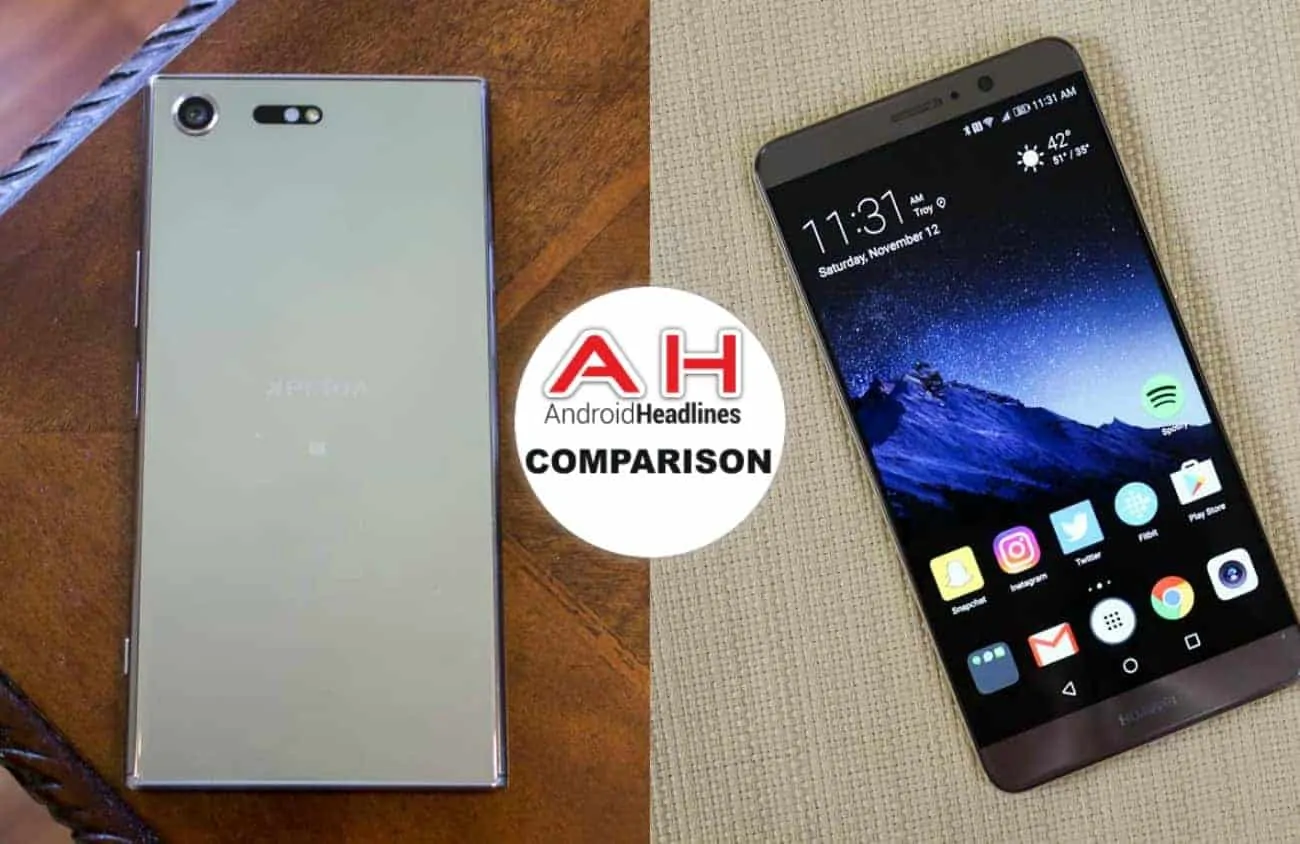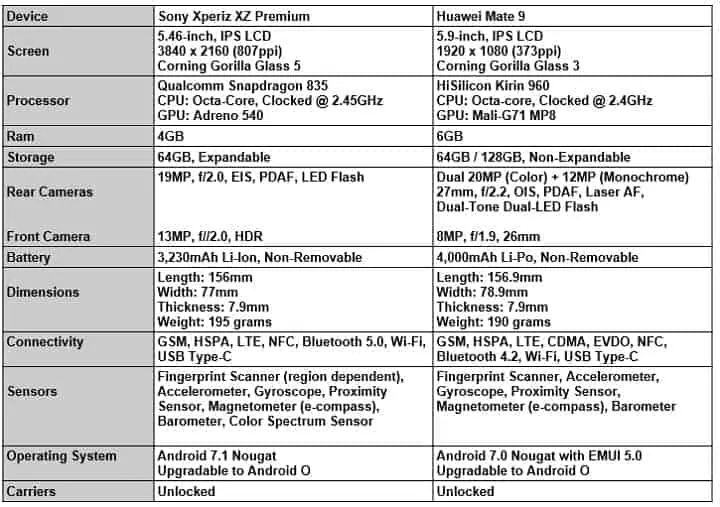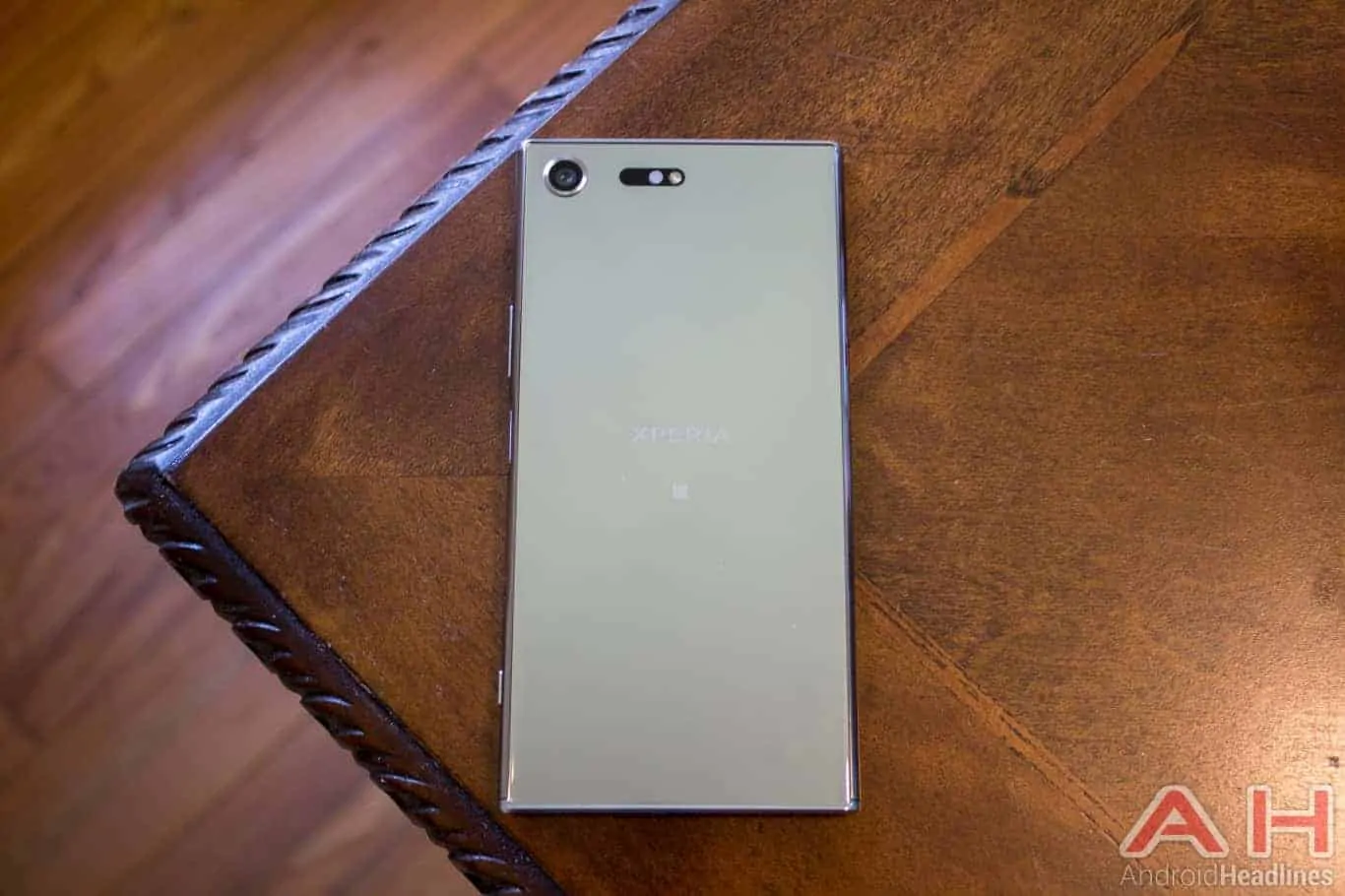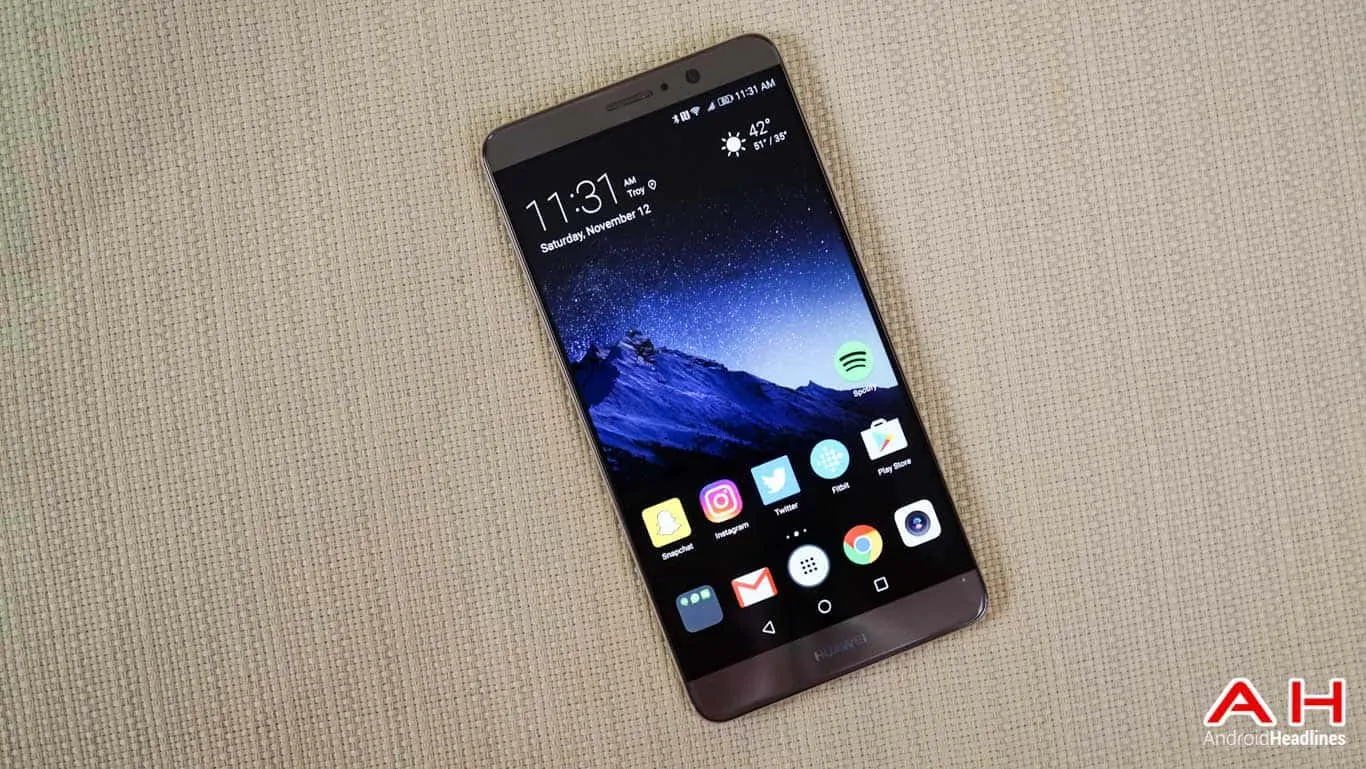Introduction
The Sony Xperia XZ Premium and the Huawei Mate 9 are among the best smartphones money can buy right now, which is why we’ve decided to compare them side-by-side to see which one represents more bang for your buck. While the former was launched earlier this year by the Japanese consumer electronics behemoth that is still struggling to get its smartphone business sorted out, the Mate 9 comes from the Chinese telecom giant that has experienced a dramatic rise in fortunes over the past couple of years and, has risen to the top of the global smartphone industry on the sheer strength of its market-share in China, where it has been the number one smartphone brand in that region for some time now. Both devices ship with premium hardware, so let’s pit them against one another and see which one deserves your money and why.
Specifications
Sony Xperia XZ Premium
The Xperia XZ Premium is Sony’s latest flagship smartphone, and as is to be expected, ships with premium hardware from top-tier vendors. On the outside, it is hands down one of the best-looking smartphones on the market today, with a sophisticated but striking ‘Loop Surface’ design. The top and bottom bezels of the device are made out of metal and have diamond-cut chamfered edges, which gives the phone a distinctive look. Much like some of its competitors in the market, the Xperia XZ Premium also comes with a glass back with Corning Gorilla Glass 5 protection. On the hardware front, the smartphone features a 5.46-inch Triluminos IPS LCD display which comes with a 4K pixel resolution (3840 x 2160) and is protected by Corning’s Gorilla Glass 5. The device is powered by the Snapdragon 835 SoC that comes with the Adreno 540 GPU alongside an octa-core CPU with custom Kryo 280 cores. While four of those cores are clocked at 2.45GHz, the other four run at a maximum frequency of 2.19GHz. The device comes with 4GB of RAM and 64GB of internal storage that can be expanded by a microSD card of up to 256GB in capacity.
The rear-facing camera on the Xperia XZ Premium comes with a 19-megapixel sensor with 5-axis electronic image stabilization (EIS), PDAF and laser autofocus along with the customary LED flash. The camera has an f/2.0 aperture, 25mm focal length and a 1/2.3″ sensor size, and can record 4K videos at 30fps and 720p videos at an astonishing 960fps, although only for very short bursts of about 0.15 seconds. The front facing camera is a 13-megapixel sensor that can record 1080p videos at 30fps and, comes with an f/2.0 aperture, a 22mm focal length, a 1/3-inch sensor size and 1.12µm pixel size. The handset carries a non-removable 3,230mAh Li-ion battery with support for Qualcomm’s Quick Charge 3.0, while cellular connectivity includes support for 4G LTE, 3G HSPA and 2G GSM standards. In terms of software, the device comes with pre-installed Android 7.1 Nougat and is likely to receive the Android O update going forward.
While the Xperia XZ Premium is a decent smartphone in general, you’ll need to remember one thing if you’re planning to buy the device in the U.S. Like its recent predecessors, it also misses out on the fingerprint scanner in its U.S. variants, so in spite of the hefty price-tag, the device doesn’t even offer a standard biometric sensor that’s become commonplace even in $100 handsets these days. On the positive side, the Xperia XZ Premium is fully waterproof and dust resistant like most Sony smartphones, and comes with an IP68 certification which means it can be submerged in up to 1.5 meters of water for up to 30 minutes at a stretch without any damage. Another big plus is the inclusion of the 3.5mm audio port, even though you still get USB Type-C connectivity for charging and data syncing.
Huawei Mate 9
The Huawei Mate 9 is the latest in a long list of Mate-series smartphones that typically ship with large displays. True to tradition, the Mate 9 also features a rather large screen that measures 5.9-inches and, is of the IPS LCD variety with a resolution of 1920 x 1080 pixels. Huawei also likes to use its own, in-house HiSilicon Kirin SoCs to power its smartphones and tablets, and again, there’s no exception to that rule with the Mate 9. The phablet is powered by the Kirin 960 SoC that comes with an integrated octa-core CPU that has four Cortex-A53 cores running at 1.8GHz and four Cortex-A73 cores running at 2.4GHz. The graphics processing duties in the chip is taken care of by ARM’s Mali-G71 MP8 GPU. The Mate 9 packs 4GB of DDR4 RAM and 64GB of internal storage that’s expandable via a microSD card.
Photography is one key area where Huawei has really upped its game these days, having tied up with German optics major, Leica, last year. The Huawei P9 series represented the first set of devices from the Chinese telecom major to ship with cameras engineered in association with Leica, and that list has only gotten larger over the past year. The Mate 9 follows the same path, and comes with a dual-camera module from the famed German brand. The dual-camera module incorporates a 20-megapixel RGB sensor for colored photos and a 12-megapixel monochrome sensor that shoots black-and-white photos. The dual-cam setup is accompanied by OIS, PDAF and Laser AF, 2x lossless zoom and a dual tone, dual-LED flash. Software features include touch focus, face detection, HDR and panorama. The front-facing selfie-cam on the Mate 9 comes with an 8-megapixel sensor that accompanied by a 26mm wide-angle lens with an f/1.9 aperture.
Like its predecessor, the Mate 9 also has a rear-facing fingerprint sensor to unlock the device and an NFC chip for compatibility with mobile payment platforms like Android Pay. The handset ships with a 4,000mAh Lithium-Polymer battery with support for the company’s proprietary SuperCharge technology that promises to charge the battery fully in just 90 minutes. On the software side of things, the Mate 9 runs Android 7.0 Nougat out-of-the-box in the form of Huawei’s trademark EMUI (Emotion UI) 5.0. The device measures 156.9mm in length, 78.9mm in width and 7.9mm in thickness, while weighing in at 190 grams.
And The Winner Is …
The Final Word
The Xperia XZ Premium and the Huawei Mate 9 are both great devices when taken in isolation, but the Mate 9 wins this one in our opinion. Huawei’s victory today has got as much to do with its ability to churn out high-quality devices at pocket-friendly price-tags, as with Sony’s inability to offer full-featured devices at remotely affordable prices. Sure, the Xperia XZ Premium is a much more aesthetically pleasing and characterful device, and is also overall a slightly faster one, what with the Snapdragon 835 running the show under the hood, but the ultra-high price-tag, coupled with the lack of the fingerprint scanner (at least in the U.S. market) means that the Mate 9 just represents much better value for your money in every way possible. Make no mistake, the Xperia XZ Premium is a great device in itself, but it will need a severe price-correction for us to start recommending it against something like the Mate 9 that matches the Sony flagship in terms of overall performance, but can be picked up right now for just under $500 on Amazon.
Buy The Sony Xperia XZ Premium Buy The Huawei Mate 9





